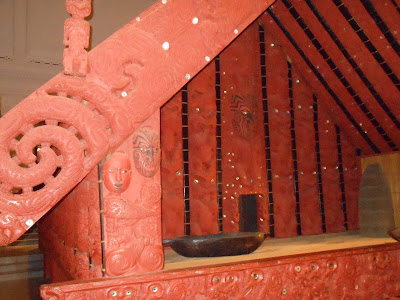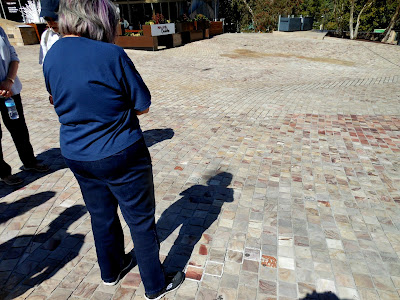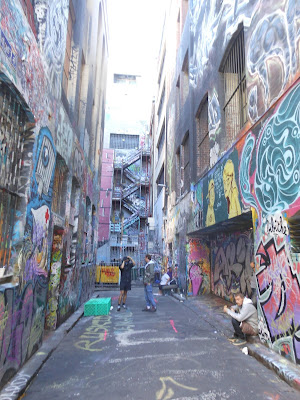At the Arapuni Swing Bridge, as we neared Taupo in the late afternoon. It was over the Waikato River, which flows from Lake Taupo all the way northwest to the ocean just south of Auckland.
Here's a map to show the general route of our tour on the North Island over the initial five days.
After Auckland, we went south through Hamilton to Taupo, and finally up to Rotorua. So, we traveled over only a small section of the island. We had originally been scheduled to spend a night in Tongariro NP (below Lake Taupo, where Rick, Beth, and Cheryl went), but that got cancelled for us. On our cruise, we had stopped in Wellington, Hastings (Napier), Tauranga, Auckland, and Bay of Islands.
On this day, we headed south through Hamilton, and down to Waitomo. We had seen this destination during our cruise, for excursions from Tauranga and Auckland, but knew we would be seeing the glow worm caves during this Gate 1 tour. We did not go to the main touristy glow worm caves, but rather a bit beyond to Ruakuri for a more intimate tour.
Therefore, I stole these two from the Internet. The one above is the way we remember seeing them.
This one is brighter than we remember, but still close. They are a species of a fungus gnat endemic to New Zealand. The larval stage produces a blue-green bioluminescence. The species is known to dwell in caves and on sheltered banks in native bush where humidity is high. Its Māori name is titiwai, meaning "projected over water".
I'm there in the dark!
We also saw this shell fossil.
After departing the caves, we drove farther south and then eastward toward Taupo. Somewhere out there, we stopped at someone's home for a nice buffet lunch in their patio/garden. This photo is in their garden (stolen from Keith). I recall that the guy was a sheep rancher, and that his wife did these lunches for supplemental income.
Janet posing in their pretty garden.
Their garden also had this cute stone tower and wall.
Originally, the tour was supposed to spend this night farther south at Chateau Tongariro, at the base of fully snow-covered and active-volcanic Mt. Ruapehu in the Tongariro National Park. Rick, Beth, and Cheryl did indeed stay there on their tour last October. It's a classic hotel built in 1887, with apparently lots of old-world charm. However, months before, we received an e-mail from Gate 1 saying that the hotel had overbooked, and we were the ones being kicked out. Thus, we were headed to Taupo.
Along the road to Taupo, we stopped for a short hike to the swinging bridge over the Waikato River.
More ferns looking upriver. That was a hydroelectric facility on the right.
On the walk back to the bus, I got this shot of a tui, native to NZ.
No more photos from this day. We arrived in the late afternoon at our resort hotel just north of Taupo. I had time to use the fitness room. We all had dinner as a group in the hotel dining room, and I recall that the service was VERY slow because the place was jammed. As a "sorry" gesture, they gave us free wine.
Nearby to the hotel were many geothermal sites, such as Crater of the Moon. The name of the road we were staying on was Thermal Explorer Highway. Interestingly, we learned just last July (after our tour) that one of my UC Davis roommates, Gene Larson, was the general manager to build the nearby huge Te Mihi Geothermal Power Station in 2010-11.
You can watch a video of Gene and the building of this factory here: https://www.youtube.com/watch?v=qmgmwinO4Gw












































































